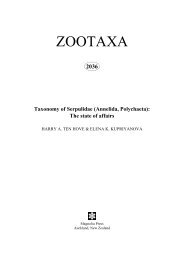Create successful ePaper yourself
Turn your PDF publications into a flip-book with our unique Google optimized e-Paper software.
Taxonomic notes:—This name, as Desmoncus polyacanthos var. prunifer (Poeppig ex Martius)<br />
Henderson, based on D. prunifer Poeppig ex Martius, was mistakenly used by Henderson (1995) for<br />
specimens here identified as Desmoncus vacivus. The type of D. prunifer was given by Henderson as Poeppig<br />
2148, although this specimen was not cited by Martius. Three sheets of Poeppig 2148 are extant at G but<br />
comprise leaves only. Two other specimens were at W but are both now destroyed, although images are<br />
extant. Neither is labeled as Poeppig 2148, although both appear to have been collected by Poeppig at the type<br />
locality. One is illustrated by Dahlgren (1959, plate 194, negative 31323) and appears to be the same species<br />
as Poeppig 2148. The second specimen at W, an image of which is present at NY (negative 31325), also<br />
appears to be the same species, and has a densely spiny peduncular bract.<br />
The images of these five specimens strongly resemble one another and three recently-collected specimens<br />
(Croat 18115, Killip 28045, Williams 785) from the same general locality, including one from Yurimaguas<br />
itself. Based on this, they are all regarded as conspecific, and the Yurimaguas specimen (Killip 28045) is<br />
designated as epitype of D. prunifer (because the type is sterile). Unfortunately these specimens still lack<br />
fruits (described by Martius as “magnitudine juglandum” but apparently lost). Desmoncus prunifer shares all<br />
character states with Desmoncus polyacanthos, but differs it its much more densely spiny peduncular bract<br />
and spinulose pinnae bases. A fourth specimen (Galeano 2113) from some distance away in Colombia<br />
(Amazonas) may also belong here. This specimen has a single fruit, but this is not unusually large and appears<br />
similar to those of D. polyacanthos. This specimen is not included in the above description but is mapped.<br />
21. Desmoncus pumilus Trail (1876: 353).<br />
Atitara pumila (Trail) Kuntze, 1891: 727. Type:—BRAZIL. Amazonas: Rio Padauiri, 26 June 1874, J. Trail 1086/LXXV<br />
(holotype K!, isotypes BM!, GH!, P!).<br />
Plants height 4.0(3.0–5.0) m; stems 0.5(0.3–0.7) cm diameter. Leaf petioles 1.7(0.5–8.0) cm long; rachises<br />
23.1(10.0–42.5) cm long, 2.6(1.9–4.4) mm wide, the spines usually
















